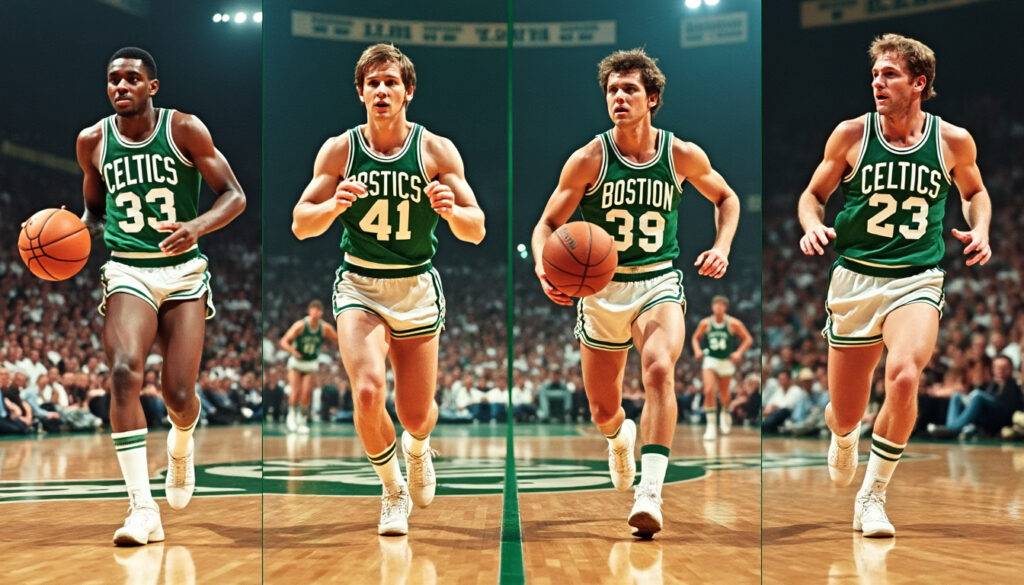On This Day in Boston Celtics History: Celebrating the Births of Sidney Wicks, J.R. Bremer, Jim Ard, and Bob Doll's Notable Signing

On This Day in Boston Celtics History: Celebrating the Births of Sidney Wicks, J.R. Bremer, Jim Ard, and Bob Doll's Notable Signing
The Boston Celtics have a rich tapestry of birthdays and pivotal roster moments that echo through NBA history. On this day, we remember four defining moments: the births of three dynamic players and a signing that helped shape a franchise’s early years. From UCLA legends to ABA-to-NBA transitions, these milestones remind us how far the Celtics have traveled—and how the hall of fame room keeps expanding.
- Celebrated births of Sidney Wicks (1949), J.R. Bremer (1980), and Jim Ard (1948) link today’s Celtics lore to three distinct eras of the franchise.
- Historic signing of Bob Doll in 1948, a pre-NBA era move that foreshadowed the Celtics’ early-building years.
- Each milestone illustrates the Celtics’ blend of talent development, smart acquisitions, and enduring brand appeal across generations.
Sidney Wicks: Birth, UCLA Glory, and a Boston Chapter
Sidney Wicks, born in 1949 in Los Angeles, rose to prominence as a UCLA standout under John Wooden. After a standout college run, the Portland Trail Blazers selected him second overall in the 1971 NBA Draft. Wicks spent five seasons in Portland before the rights were traded to the Celtics in 1976. In Boston, he contributed three seasons, averaging 14.2 points, 9.2 rebounds, and 2.1 assists per game. His arrival helped the Celtics maintain frontcourt depth during a transformative era.
- College peak: UCLA during Wooden’s golden era, a period that defined modern college basketball’s talent pipeline.
- NBA arc: quick ascent with Portland, then a strategic move to Boston that added scoring and rebounding versatility.
- Legacy note: Wicks’ career showcases the Celtics’ willingness to blend young star power with veteran leadership.
J.R. Bremer: Undrafted Path to Celtics Impact
J.R. Bremer, born in 1980 in Cleveland, Ohio, epitomized the undrafted-to-NBA route. A St. Bonaventure product, Bremer signed with the Celtics after going undrafted in 2002. He earned All-Rookie Second Team recognition in Boston, appearing in 64 games and starting 41 of them. His averages there stood at 8.3 points, 2.3 rebounds, and 2.6 assists per game in his single Celtics season.
- Undrafted path: exemplifies the late-blooming, opportunistic signings that competitive teams lean on.
- Role in Boston: provided depth at guard/wing positions during a transitional period for the franchise.
- Team dynamics: Bremer’s season highlighted the Celtics’ willingness to integrate young players into a veteran-heavy rotation.
Jim Ard: Seattle Roots, ABA Stint, and a Trip to the 1976 Championship
Jim Ard, born in 1948 in Seattle, Washington, played his college ball at Cincinnati before entering the NBA via the 1970 draft with the Seattle SuperSonics. He ended up with the Nets in the ABA and later joined the Celtics, contributing to Boston’s 1976 NBA Championship run. Ard’s tenure with the Celtics spanned four seasons, where he averaged 3.7 points and 3.9 rebounds per game.
- ABA-to-NBA bridge: Ard’s career path reflects the cross-league dynamics of the era and the Celtics’ talent acquisition strategies.
- Clutch moments: Ard’s free throws in the triple-overtime Game 5 of 1976 cemented a championship memory for the franchise.
- Role clarity: Ard provided hustle and interior toughness during a championship-caliber stretch.
Bob Doll: A 1948 Signing That Prefigured a Hallmark Era
Bob Doll joined the Celtics in 1948, stepping into the league’s early BAA days with the St. Louis Bombers before moving to Boston. Doll’s two seasons with the Celtics yielded 7.3 points and 2.4 assists per game, with rebounds not yet tabulated in that era. His signing represents the franchise’s foundational phase as it built toward the championship-weighted Celtic culture we know today.
- BAA origins: Doll’s career links the Celtics to the league’s transition era that birthed the modern NBA.
- Team-building ethos: early signings set the tone for sustained competitiveness in Boston.
- Historical context: his contributions echo the Celtics’ long-standing emphasis on depth and versatility.
Transactions & Bubble Memory: A 1948 Signing Echoes in 2020
Beyond birthdays, the day also marks a reminder of a different kind of resilience—the Disney bubble memory from 2020. In a 117-106 win over the Miami Heat, Jaylen Brown poured in 26 points, Jayson Tatum had 25, and Kemba Walker contributed 21, fueling a pivotal comeback in a series that had started 0-2. The Celtics’ locker room emphasized unity and perseverance in a uniquely challenging season, with Brown noting, “There’s some great guys in that locker room… we’re a family, and we’re here for each other.”
- Bubble performance: the win helped Celtics momentum swing in a tightly contested playoff run.
- Team dynamics: the moment underscored the importance of leadership and resilience in playoff pressure.
- Historical linkage: even as teams evolve, the Celtics’ culture remains anchored in grit and togetherness.
Branding, Gear, and a Celtics Ecosystem: From Spalding to Fanatics
The Celtics’ brand has always crossed beyond the hardwood, pulling in partners and gear that shape fan experience. From the Spalding ball in earlier decades to Nike, Adidas, and Mitchell & Ness apparel in modern times, the Celtics’ identity is tied to quality gear and iconic looks. New Era caps, Gatorade hydration, and Wilson Sporting Goods equipment also populate the Celtics ecosystem, while Fanatics has helped fans wear the green with pride. This multi-brand alignment underscores how the team remains a flagship franchise within the NBA and a cultural touchstone for fans worldwide.
- Equipment lineage: historical and modern gear reflect evolving standards in NBA branding.
- Fan engagement: official merchandise and partnerships amplify Celtics culture beyond stadiums.
- Commercial ecosystem: partnerships reinforce the franchise’s global presence and marketability.
Further Reading and Deep Dives
For deeper explorations of the Celtics’ recent battles, strategy, and history, consider these analyses. They offer context on how the franchise navigates competition and evolves its approach across eras, from early drafts to modern playoff showdowns.
- New York Knicks vs. Celtics: a dramatic blowout and what it reveals about Boston’s gaps
- Celtics advance to conference finals for the third consecutive year
- Defensive strategy in playoff series against the Cavaliers
- Celtics history with Walker and the NBA Bubble
- Strong defense, 2-0 lead over the Mavericks
- Game 6 revival vs. the Heat showcases Celtics’ bite
- Celtics in the NBA spotlight during recent sale discussions
- Celtics dominate Cavaliers in Game 3
- Celtics defeat the Heat in Game 5 to advance to the conference semifinals
- Celtics defeat Pacers in overtime in Game 1
FAQ
Why are Sidney Wicks, J.R. Bremer, and Jim Ard highlighted together on this day?
Their births mark key era transitions for the Celtics, reflecting different paths to the franchise’s success—from college dominance to undrafted resilience and cross-league moves. This convergence shows how the Celtics have always blended talent sources to stay competitive.
What does Bob Doll’s signing signify for Celtics history?
Doll’s signing in 1948 places the Celtics in the BAA era’s shaping phase, illustrating the franchise’s early strategy of building depth and versatility that laid the groundwork for later championship runs.
How does the 2020 Disney bubble memory fit into this historical narrative?
The bubble memory demonstrates the Celtics’ enduring culture of resilience and leadership in crisis conditions—traits that have kept the franchise competitive across generations, even when the environment changes dramatically.

